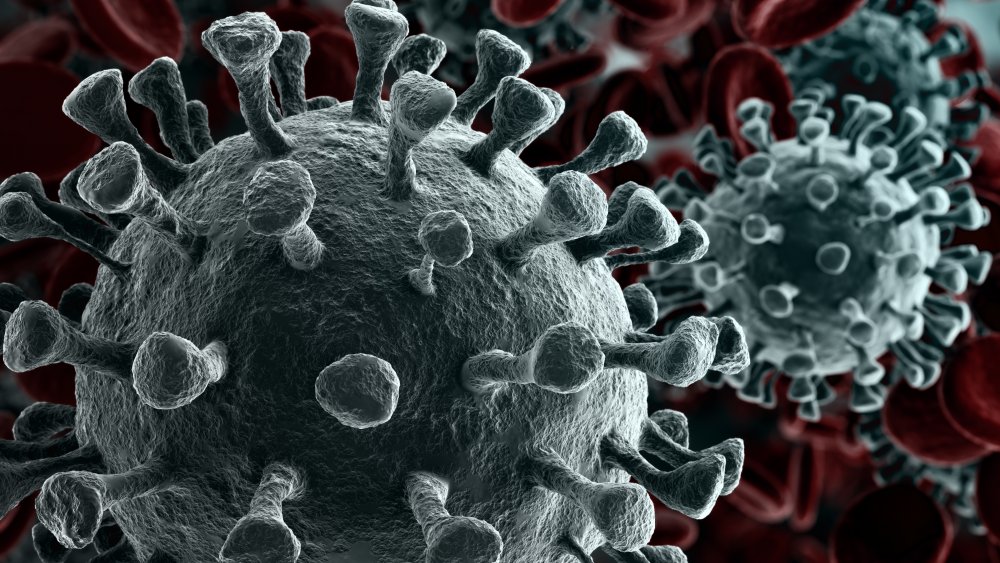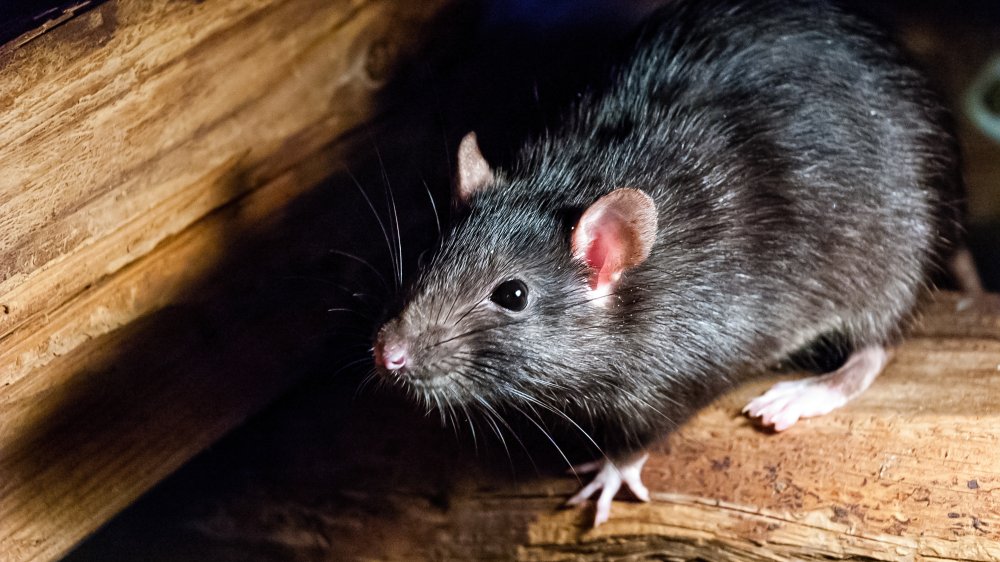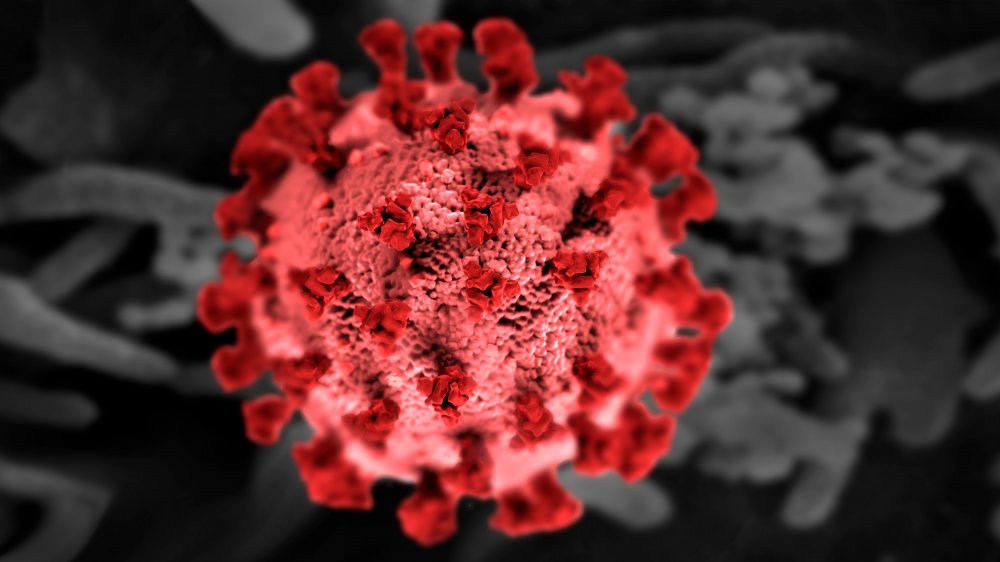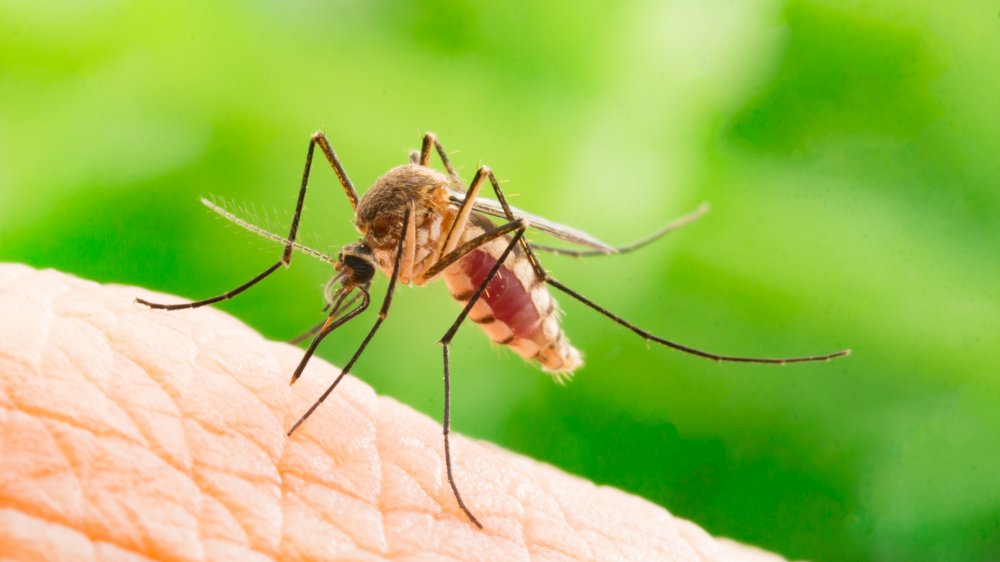The Deadliest Viruses Still In Existence
It doesn't matter how tough you are, how well you eat, how often you exercise, or how often you tell people that you're vegan, a virus doesn't discriminate. It sees everyone as a viable host, and that's what makes an outbreak so terrifying.
For example, one of the most devastating outbreaks in recent history — and by recent, we just mean within the last few hundred years — was the Spanish flu. It hit on the eve of World War I, was incubated in the unsanitary conditions of the front lines, and was spread all over the world by soldiers returning home in what should have been a happy occasion. According to the BBC, somewhere between 50 and 100 million people died during the Spanish flu outbreak, and that's unfathomable — especially considering the entirety of World War I had claimed around 20 million lives.
In other words, viruses are no joke, and while no one is coming down with that particular strain of flu any more, there are plenty of ultra-deadly viruses still out there. Seriously, the world is crawling with terrifying diseases, some of which are relatively new and some of which have been around for a while. Whether they're spread by bats, dogs, or people, these are the deadliest viruses still in existence.
Marburg is the reason why we fear bats
In 2018, The Washington Post was reporting on a research team from the US Centers for Disease Control and Prevention, who'd teamed up with the Pentagon's Defense Threat Reduction Agency in order to study bats in Uganda. Why? They wanted to know where they were going when they left their caves, because those bats had been linked to several cases of Marburg. It's a disease that the CDC says is caused by a virus that's first spread from bat to human, likely through "unprotected contact with infected bat feces or aerosols," then between people, through direct contact with other infected bodily fluids.
And it's shockingly deadly, killing up to 90 percent of those who are infected.
It was first identified in 1967, when African green monkeys who were infected with the virus were sent to laboratories in Belgrade, Germany, and Yugoslavia. Within a week, several lab workers were dead, and since then, hundreds of people have died during dozens of outbreaks — mostly located near bat caves.
It's an awful way to die, and most people who get it do, in fact, die. The symptoms include things like fever, chills, and a rash, which the CDC says then turns into nausea, chest pain, and vomiting. It gets progressively worse, turning into delirium, shock, and finally ending in massive hemorrhaging and multi-organ dysfunction. Bottom line? Just stay out of bat caves.
Influenza A is the flu on steroids
Looking at influenza is extremely complicated, but let's talk about the deadliest one, and according to the CDC, that's the influenza A virus. (There are actually four different categories: A, B, C, and D.) A is the only one that's caused massive pandemics, and it's also the one that can undergo a fast, drastic change called an "antigenic shift." When that happens, that's when it can spread from an animal population to humans, and it's not long after that you'll start to see headlines about things like avian flu.
Influenza's chameleon-like ability to shift and change makes it incredibly dangerous. Take the 2009 outbreak of H1N1 or swine flu. The CDC estimates that during the first year of the outbreak, around half a million people died from it. And while typically, the most susceptible demographics include the very young, the very old, and the immune-compromised, this particular flu targeted people younger than 65. And it's still out there. Between 2009 and 2018, around 75,000 people died from it.
That's an entirely different thing from seasonal flu, which goes around every year, usually between December and February. That, we're prepared for, because most people have been exposed to the virus before or have had some kind of immunization that helps protect us. It's when the virus changes that terrible things happen because we have no previous immunity or defenses. Everyone's immune system is starting from scratch, and we all know how long project planning takes.
Ebola is rare ... and relentlessly deadly
According to the World Health Organization, Ebola is pretty rare. When the virus does make the jump to human populations — usually coming from close contact with animals like gorillas, chimpanzees, and monkeys, but it can also come from bats, antelope, and porcupines — it can have a fatality rate of anywhere from 25 to 90 percent, depending on the outbreak.
The virus that causes Ebola was first discovered in 1976 — when it wiped out a lot of people — and treatment is still supportive. Sadly, one of the groups at the highest risk for being infected are healthcare workers who are treating patients, as the virus can spread through blood or other bodily fluids. Ultimately, though, the CDC says researchers still aren't sure where the virus originates, but they do know that there's at least six different versions of it that cause illness in various animals. Four of those can infect and kill people.
Symptoms can take as long as 21 days to appear (but a person isn't contagious until they're symptomatic) and include things like fatigue, muscle pain, headache, fever, and sore throat. That escalates quickly into vomiting, diarrhea, and impaired kidney and liver function, often with internal and external bleeding. It's a terrible way to go.
The rabies virus is insanely fatal
Part of childhood is being traumatized by the "classics," and that's definitely true of Old Yeller, the tale of a boy who's forced to shoot and kill his beloved dog after the pup contracts rabies. Isn't the innocence of childhood a wonderful thing?
But it absolutely is a cautionary tale, and there's good news. The CDC says that rabies is completely and absolutely preventable, and you can definitely keep your pets (and you) safe. But it's also completely and absolutely fatal if it's left untreated.
The rabies virus is transmitted through direct contact between broken skin, mucous membranes, and infected tissues or saliva. Most often, that's a bite from an animal that's infected. Technically, any mammal can get rabies, but it's most often seen in skunks, foxes, bats, and raccoons.
Rabies is also pretty tricky. Early symptoms are similar to the symptoms of the flu, and it can take months to progress to the point where the patient suffers from some strange things that start with anxiety, confusion, and "cerebral dysfunction." That escalates into insomnia, hallucinations, delirium, and a fear of water in an acute period that lasts somewhere between two and ten days. Less than 20 people have been documented to have survived a diagnosis of clinical rabies, so bottom line? If you've been bitten or scratched by a wild animal, consult a healthcare professional. They'll assess your risk, and immediately start treatment if they decide it's the best course of action. Otherwise, you might end up like Old Yeller.
The dengue virus will put a damper on your Caribbean vacation
Dengue fever might sound like something that only explorers in the 17th century had to worry about, but according to the CDC, around 40 percent of the world's population lives in areas where it's still a significant risk.
Every year, around 22,000 people die from it, and millions more get sick. It's caused by a virus that's spread by mosquitoes (the deadliest animal in the world), and as far as a vaccine goes, there's good news and bad. The good news is that there is a vaccine, but the bad news is that it's only recommended for people between nine and 45 years old. And if someone is vaccinated then still gets dengue, they're at a higher risk of getting severe dengue ... which is, of course, the deadly stuff. Once severe dengue develops, death can follow within just a few hours.
For most people, it's the fever that's the worst. Then, there's the aches and pains, along with the rashes and the very, very specific symptom of major eye pain. Once it turns into severe dengue, though, that's heralded by vomiting (and vomiting blood), bleeding from the gums and nose, and it can end in shock and death resulting from severe internal bleeding. If you're traveling, plan appropriately.
You can blame rodents for the deadly hantavirus
According to the American Lung Association, hantavirus doesn't discriminate, and even healthy adults with no previously existing conditions or weaknesses can develop it. It's the result of a virus that's present in the stuff left behind by rodents, including saliva, urine, and droppings. So yes, if you spot rodent droppings in your house or if you've recently been traveling through rural areas, there's the chance of it spreading.
Hantavirus is a fairly recent discovery. In 1993, a group of otherwise healthy adults suffered sudden breathing difficulties and, finally, respiratory failure. The virus was detected by blood tests, and a campaign to track down the source of the virus led to a large population of infected deer mice. The mice — and other rodents that carry the virus — do only that: carry. They're not affected, but when they infect people, it's a nasty bit of business. After first attacking the lungs, heart, and kidneys, the virus spreads throughout the body. As the immune system struggles to control the infection, inflammation becomes a major problem, damaging organs and causing blood vessels to leak.
Fatalities vary between 10 and 50 percent, as there are a few different strains of hantavirus. There is currently no cure, treatment is largely supportive, and that usually involves being transferred to a hospital with mechanical ventilators and kidney dialysis. The good news is that if you do survive, there are no long-lasting effects.
HIV/AIDS has taken millions of lives
What we now know as HIV/AIDS was first identified in 1981, and according to the US Department of Health & Human Services, it's remained one of the world's deadliest epidemics. Here's how it works.
The virus is spread from the fluids of an infected person through the mucous membranes of another, where it enters into the bloodstream. That most commonly happens during sex or by sharing needles during drug use, but it can also spread from a mother to a breastfeeding baby, by receiving blood transfusions or organ transplants, or from a severe bite from an HIV+ person.
Once the virus is in, it goes right for the immune system. There's no cure, although there are treatments which have been proven to keep people healthy and stop the virus from spreading to others. These treatments have even been found to stop the development of AIDS, as long as it's continuously taken according to instructions.
Without treatment, HIV will progress into AIDS, and when that happens, the average expected life span is about three years. It's typically not the virus that kills a person but their vulnerability to other diseases, conditions, and cancers. It's also worth pointing out that the Mayo Clinic notes that HIV/AIDS is not spread through casual contact like hugging, kissing, or shaking hands. Tragically, it's been estimated that over 70 million people have contracted the disease and over 30 million have died from it.
Believe it or not, smallpox still exists
The National Institute of Allergy and Infectious Diseases says that in 1980, the World Health Organization declared that smallpox had been officially eradicated thanks to the success of a global vaccination program.
But, there's a catch.
Smallpox is nasty. According to Forbes, it infected around 300 million people just in the 20th century and killed about 100 million. Those that contracted the disease suffered from not just blisters, but blisters so bad they caused blindness and permanent disfigurement in survivors. And here's the thing — scientists are now worried that thanks to global warming and the melting of ice that's been frozen for a long, long time, smallpox might be just waiting to make a comeback. And yes, there's a precedent for it. Melting ice in Siberia released anthrax, which hospitalized 24 people.
Scientists are still researching smallpox, which is caused by the variola virus, and it's not just because of the possibility that global warming is going to unleash another pandemic. There's also the possibility that it could be weaponized. A few vials of it still exist, and it's possible there are more out there than we know. In 2014, the National Institutes for Health announced (via The Guardian) they'd found a few vials in a storeroom, so while it might be eradicated, it's not entirely gone yet.
Coronavirus has been around for a while
On December 31, the year 2019 made it clear it wasn't going out without one last parting shot. That's when the World Health Organization was informed of a coronavirus outbreak in Wuhan, China, one that was eventually named COVID-19. The name change came because this isn't the first time the world has seen a coronavirus outbreak, not by a long shot.
According to the CDC, the SARS outbreak that spread to more than two dozen countries in 2003 was also caused by a coronavirus. In that outbreak, 8,098 people were infected, and 774 died from a severe respiratory illness that often turned into pneumonia. Like COVID-19, SARS was spread most easily through respiratory droplets, i.e. coughing and sneezing.
Then, in 2012, there was another coronavirus outbreak. This one was called MERS, and it was centered around Saudi Arabia. This version of the virus was particularly dangerous for those with pre-existing heart, kidney, or lung conditions, or those with already compromised immune systems. The fatality rate was around 30 to 40 percent.
And that shows just how many different strains of coronavirus there are. Scientific American says four strains in particular cause about a fifth of all common colds, and the virus family's recent propensity to mutate has researchers scrambling.
Measles is still in existence and still deadly
In 2019, the World Health Organization reported that once again, there'd been an increase in the number of measles cases. Why? Well, as they put it, "The disease has spread fast among clusters of unvaccinated people."
And that's resulted in the deaths of young children.
In 2016, the WHO declared the UK to be measles-free, and in 2019, the BBC was reporting that the designation had been taken away, as there was a steep increase in cases because of people who passed on the vaccination. And it's a huge deal. In 2018, measles killed more than 140,000 people (via the WHO), and in 2017, around 110,000 died. Most were children under five years old. In addition to the potential to be deadly, measles can come with all kinds of other nastiness, including blindness, encephalitis (or swelling of the brain), severe diarrhea (and consequently, dehydration), and pneumonia — all of which are serious complications, especially for the very young.
According to the CDC, the US started keeping track of measles cases in 1912. In the first ten years, there was an average of 6,000 deaths each year. They also report that even though the US was declared measles-free in 2000, that's not the whole story. It doesn't mean there's no cases of measles. Instead, it means that the only cases were ones brought in by travelers. And that? That means it still exists, so there's still a good reason to get those vaccinations.
Stay away from the rats if you don't want lassa fever
Lassa fever is sneaky. According to the World Health Organization, it's not only endemic in the rat populations of West Africa, but about 80 percent of the people who contract the virus show no symptoms. Overall, the fatality rate is only 1 percent, and that doesn't sound so bad as far as viruses go ... right?
Not so fast. They also say that pregnant women are extremely susceptible to the disease, and of the women who contract the disease in their third trimester, 80 percent will die, lose their child, or both. And diagnosing it is difficult. It's spread through contact with objects — particularly household items or food — that have been contaminated with rat droppings. Symptoms are extremely varied, and at the beginning, the most common is just a general feeling of being run-down. When that escalates, though, it turns into bleeding from various orifices, shock, seizures, and coma.
There are no vaccines, and keeping the disease at bay largely means taking precautions to keep the rats away. The WHO recommends not just storing food and grain in rat-proof containers but keeping cats. Who says cats don't earn their keep?
Yellow fever does make you turn yellow
It's called yellow fever because jaundice is one of the early symptoms. (Jaundice turns your skin yellow, and it's no laughing matter.) According to the World Health Organization, there are 47 countries in Africa, Central, and South America where yellow fever is endemic. In 2013 alone, the organization logged as many as 170,000 severe cases and 60,000 deaths.
It's caused by a virus that's transmitted to humans through mosquitoes, and since there are a few different types of mosquitoes living in different environments, there are different types of yellow fever. The symptoms are mostly the same, though, and include fever, muscle pain and headache, chills, nausea, and specifically, backache. Many people get better in just a few days, but if the case turns severe, it escalates into failing kidney function, as well as bleeding from the eyes, nose, mouth, and stomach. And here's where one of two things can happen. People might recover in around two weeks ... or they die.
There's sort of good news. There is a vaccine that's available and incredibly effective, but the WHO says we're probably never going to be able to get rid of the disease completely. Doing that would mean getting rid of mosquitoes, their natural habitats, and eliminating it in the animal hosts those mosquitoes pick it up from ... but cutting out the middleman doesn't sound like such a bad idea.












